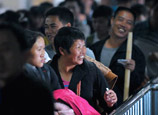
Key Words: Chinese economy; Growth model; External demand; Consumption
Related Reading:
>> Chinese urbanites' income grows in 2012
>> China's industrial output growth decelerates in 2012
>> China's economic slowdown not a concern
Many signs have shown that the external environment and internal factors driving China’s rapid economic growth over the past 30 years have changed.
External demand declines, leading to export slowdown
The growth of an emerging economy is mainly driven by the production and exportation of primary products in its early stages, and China is no exception. As of the end of 2011, Chinese exports accounted for more than 10 percent of the world’s total.
International experience shows that when a country’s exports account for 10 percent to 12 percent of the world’s total, its exports will have rather limited room for further growth.
After the global financial crisis, the “dividend” of globalization brought about China’s accession to the World Trade Organization has begun fading, and the favorable conditions for its rapid export growth have disappeared.
Investment faces limited room for growth
China has maintained a high investment rate for many years, and it is becoming increasingly difficult to boost economic growth through exports.
First, the country’s marginal efficiency of investment has dropped. After rapid capital intensification, its return on investment has dropped below that of many other countries.
Second, China’s savings rate decline will affect its high investment rate. The savings rate will decline steadily due to the country’s increasing aging population and growing number of retirees. Its savings rate is expected to drop between 5 and 7 percentage points from 2008 to 2015.
Third, the proportion of China’s industrial added value in gross domestic product (GDP) has reached its peak. The country’s industrial added value accounted for nearly 43 percent of GDP in 2008, reaching peak levels of major developed economies. The industrial added value-to-GDP ratios of industrialized countries have all dropped steadily after reaching peak levels. China’s industrial added value-to-GDP ratio is close to limit, and the growth rate of its industrial investment is unlikely to further increase substantially.
Fourth, the manufacturing sector is facing structural overcapacity. The problem will deteriorate if the country blindly increases investment and fails to accelerate promoting the new round of industrial transformation and upgrading.
Fifth, real estate investment is stabilizing. China is still in a critical period of regulating its real estate market, and faces heavy pressure of home price rebound. It will continue strict property controls to drive speculative capital out of the market.
Sixth, government-led infrastructure investment will have limited room for further growth. Certain regions face infrastructure saturation and even excessive and premature infrastructure investment growth.
Consumption rate drops steadily, faces various obstacles to growth
Investment growth fundamentally depends on consumption demand. A proper consumption rate is crucial to ensuring sustainable and healthy economic development.
However, China’s consumption-to-GDP ratio has dropped steadily over the past 30 years and now stands at 36 percent, lower than that of the developed countries in North America and Europe as well as certain developing countries such as India.
Many factors have affected the growth of China’s consumption demand.
First, the proportion of residents’ income in national income has dropped, and the consumption rate has been on a steady decline. The proportion of workers’ income in national income dropped by 11.7 percentage points from over 51 percent in 1995 to nearly 40 percent in 2007, and the proportion of national income spent on residents dropped from over 69 percent in 1996 to over 57 percent in 2008.
Second, China has not established a sound social security system. Residents are becoming less willing to buy things. The social security system, including medical insurance, remains defective, and government spending on education is relatively low. Most low-income families are more willing to save their money in case of emergencies, and people’s interest in consumption has declined. Furthermore, sky-high home prices have led to a serious overdraft of people’s income for as long as 20 years, and made them spend less on other things.
Third, the gap between the rich and poor is still widening, and overall social consumption is unlikely to grow rapidly.
Fourth, there is a serious lack of industrial upgrading and high-end products in China. For example, the majority of rich Chinese people have chosen to buy luxury goods overseas, while luxury goods could have contributed heavily to domestic consummation growth.
From the perspective of demand, the preconditions for China’s long-standing export- and investment-driven economic growth model have changed fundamentally.
Read the Chinese version at: 增长动力趋减与下行压力, Source: People's Daily
















 Beijing fantasy emerges in dense fog
Beijing fantasy emerges in dense fog


![]()
